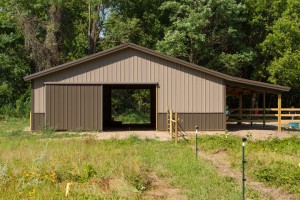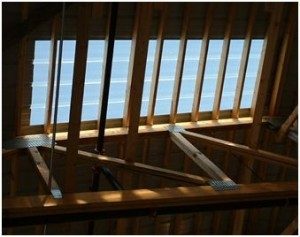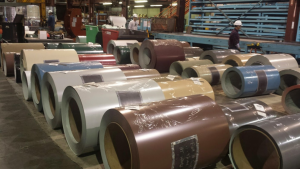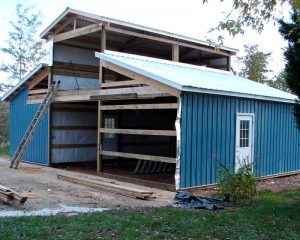Kynar Paint for Barndominiums
Many potential barndominium owners are looking to get the greatest value for their investment and many see this as their ‘forever’ home. If you fall into this category, I would highly recommend exploring Kynar® painted steel.
I could extol aesthetic reasons to use Kynar painted steel for longer than anyone would be willing to listen.
Polyvinylidene fluoride is acknowledged as the premium resin for coil coatings. Popularly known by its original trade name Kynar, PVDF is a kind of fluoropolymer, a family which includes Teflon and Halar. Key to these chemicals’ toughness is the bond between carbon and fluoride, the strongest possible polymeric connection.
PVDF resin has superior chalk resistance and gloss retention, as well as stain and chemical resistance. It is softer than SMPs and polyesters, however, making it highly formable without risk of cracking, but also relatively easy to scratch during transport or installation. PVDF is most durable when it makes up 70 percent of resin; higher concentrations do not coat well, since acrylic is important for dispersion during coating processes.
 There are two general classes of pigments. Organic, or carbon-based, pigments are generally synthetic and relatively inexpensive to make. However, organics have fairly weak molecular bonds which are easily broken down by moisture, UV and pollutants, and so, are prone to fading. Inorganic pigments are those which do not contain carbon, and may be naturally occurring or manufactured. They generally offer good fade resistance, with an exception of carbon black. Many simple inorganics are metal oxides, such as widely used iron oxide and titanium dioxide.
There are two general classes of pigments. Organic, or carbon-based, pigments are generally synthetic and relatively inexpensive to make. However, organics have fairly weak molecular bonds which are easily broken down by moisture, UV and pollutants, and so, are prone to fading. Inorganic pigments are those which do not contain carbon, and may be naturally occurring or manufactured. They generally offer good fade resistance, with an exception of carbon black. Many simple inorganics are metal oxides, such as widely used iron oxide and titanium dioxide.
Kynar 500/Hylar 5000 systems, which are required to contain 70 percent PVDF, do not vary greatly between manufacturers. Since these paints carry 20- to 30- year warranties which allow for extremely little face, these companies all use ceramics and appropriate inorganic pigments.
One manufacturer we purchase Kynar 500 painted steel from is McElroy Metal. Here is a photo which really shows off performance differences between Kynar and SMP: http://www.mcelroymetal.com/elements/files/Kynar%20500%20VS.%20SP%20Flyer
Sadly, PVDF paints are not available nationwide. Personally – if available where I was planning to build and color choice was other than White, I would make an investment for better paint. I want my building to look as close to new as possible, for as long as I own it!
At NFBA’s (National Frame Building Association) 2019 Expo I cornered Sherwin-William’s representative for further information on Fluropon® (PVDF). Please enjoy this video:
https://drive.google.com/open?id=14fzlL1agiMOZ6Sq67ce6H5JrF9iSc1Kp
 Now, considering your entire roof is 40 years old – it would be possible to replace only skylight panels. This would be providing rib configuration of steel can be matched. Over 40 years many patterns have been discontinued.
Now, considering your entire roof is 40 years old – it would be possible to replace only skylight panels. This would be providing rib configuration of steel can be matched. Over 40 years many patterns have been discontinued.
 Silicone-modified polyester systems vary greatly in quality. Polyester quality outweighs silicone content in importance, but SMPs still outperform straight polyesters in chalk resistance. A more important difference is in pigment type and quality. Some formulations use the same ceramic pigments as PVDFs; others rely on simple inorganics or organics. Since the better resin does little to prevent an organic pigment from fading, paying for silicone is no excuse for going cheaper with pigment.
Silicone-modified polyester systems vary greatly in quality. Polyester quality outweighs silicone content in importance, but SMPs still outperform straight polyesters in chalk resistance. A more important difference is in pigment type and quality. Some formulations use the same ceramic pigments as PVDFs; others rely on simple inorganics or organics. Since the better resin does little to prevent an organic pigment from fading, paying for silicone is no excuse for going cheaper with pigment. The pencil hardness test is very simple to do, gives uniform results, and is dependable because the pencils are graded. The grade of the pencil is determined by the amount of baked graphite and clay in its composition.
The pencil hardness test is very simple to do, gives uniform results, and is dependable because the pencils are graded. The grade of the pencil is determined by the amount of baked graphite and clay in its composition. The Chevelle had its original factory paint – Marina Blue Polyester from Ditzler® Automotive Finishes. After nine years of probably being rarely (if ever) garaged, the Chevelle’s paint had faded. Significantly. Chevrolet’s Marina Blue had faded to a bluish tinted off-white.
The Chevelle had its original factory paint – Marina Blue Polyester from Ditzler® Automotive Finishes. After nine years of probably being rarely (if ever) garaged, the Chevelle’s paint had faded. Significantly. Chevrolet’s Marina Blue had faded to a bluish tinted off-white.




